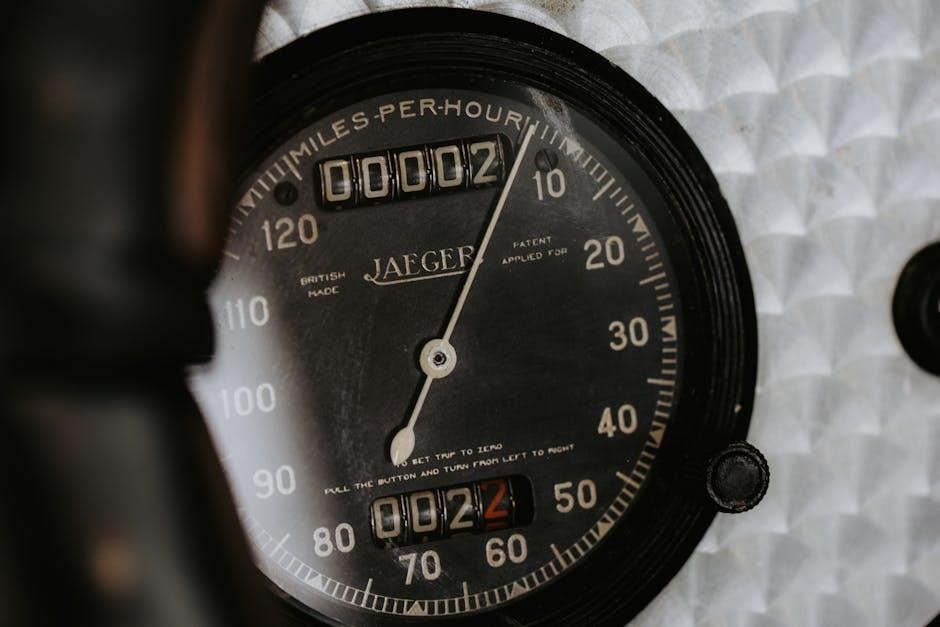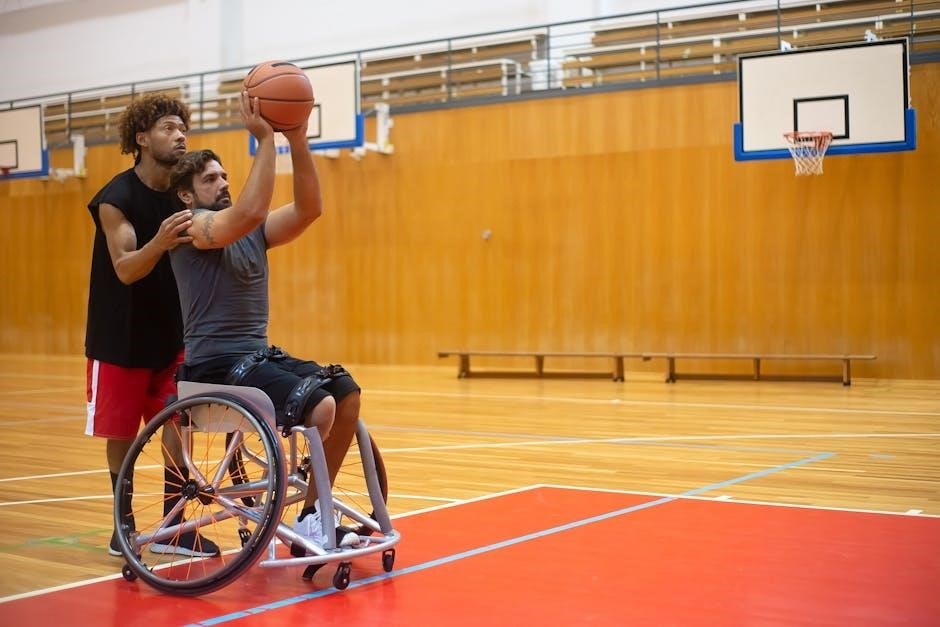This guide provides a comprehensive overview of wheelchair measurements, ensuring optimal fit and comfort. Proper sizing is crucial for mobility, independence, and health. Learn how to measure accurately and explore resources for manual and powered wheelchairs.
1.1 Importance of Proper Wheelchair Fit
A proper wheelchair fit is essential for ensuring comfort, mobility, and overall well-being. A well-fitted wheelchair prevents health issues such as pressure sores, poor posture, and shoulder pain, which can arise from incorrect sizing. It also enhances stability and maneuverability, reducing the risk of accidents. Proper fit promotes independence, allowing users to navigate their environment with ease. Additionally, it boosts confidence and quality of life by enabling participation in daily activities and social events. Correct measurements ensure the wheelchair supports the user’s body correctly, accommodating factors like cushion thickness and clothing. Environmental fit is also crucial, as the chair must navigate through doorways, hallways, and other spaces safely. A proper fit not only improves physical health but also addresses long-term comfort and accessibility needs, making it a cornerstone of effective wheelchair use.

1.2 Purpose of a Wheelchair Measurement Guide
A wheelchair measurement guide serves as a vital tool to ensure users achieve the optimal fit for their mobility needs. Its primary purpose is to provide clear, step-by-step instructions for measuring the body and selecting the appropriate wheelchair dimensions. By following the guide, users can avoid ill-fitting chairs that may lead to discomfort, reduced mobility, or even long-term health issues like back pain or pressure sores. The guide also helps users understand their specific requirements, such as seat width, depth, and backrest height, ensuring the chair supports their body correctly. Additionally, it aids in considering factors like cushion thickness, clothing, and environmental accessibility, making it an essential resource for both first-time users and experienced individuals seeking a better fit. The guide’s ultimate goal is to empower users with the knowledge to select or adjust a wheelchair that enhances their independence, comfort, and overall quality of life.

1.3 Types of Wheelchairs and Their Measurement Needs
Understanding the different types of wheelchairs and their measurement needs is crucial for selecting the right chair. Manual wheelchairs, often lightweight and foldable, require precise seat width, depth, and backrest height measurements to ensure ease of use and maneuverability. Power wheelchairs, designed for those with limited strength, need accurate measurements for stability and control, including armrest height and footplate length. Pediatric wheelchairs must be tailored to growing children, with adjustable features to accommodate physical changes. Bariatric wheelchairs, built for heavier users, require reinforced frames and higher weight capacities, necessitating careful measurement of seat width and overall dimensions. Athletic and sports wheelchairs prioritize performance, with measurements focused on optimizing speed and agility. Each type has unique measurement considerations to ensure proper fit, safety, and functionality, making it essential to tailor the measurement process to the specific wheelchair and user needs.

Key Measurements for a Manual Wheelchair
Measure seat width, depth, and backrest height for proper fit. Armrest height and footplate length ensure comfort. Overall dimensions impact mobility and accessibility, ensuring the chair suits various environments and user needs effectively.
2.1 Seat Width Measurement
Accurate seat width measurement ensures a comfortable and functional fit. Measure the widest point across the user’s hips while seated. Add 1-2 inches for clearance and adjust for cushion thickness. Proper fit prevents pressure sores and enhances mobility.
2.2 Seat Depth Measurement
Measuring the seat depth is essential for ensuring proper posture and comfort. To determine the correct depth, measure the distance from the back of the knee to the buttocks while the user is seated. Subtract the thickness of any cushion to achieve the optimal depth. A seat that is too deep can cause discomfort and restrict movement, while a seat that is too shallow may not provide adequate support. It is important to consider the user’s body proportions and any specific needs, such as pressure relief or mobility requirements. Proper seat depth ensures the user can sit comfortably without slouching or feeling cramped. Always consult a professional for precise measurements and adjustments to guarantee the best fit. Regular checks and adjustments are recommended to accommodate any changes in the user’s condition or preferences.
2.3 Backrest Height Measurement
Measuring the backrest height ensures proper spinal alignment and comfort. To determine the correct height, measure the distance from the seat surface to the top of the shoulder or the desired support point. The backrest should provide adequate support without restricting movement or causing discomfort. For users requiring upper body support, the backrest height may need to be higher, while active users may prefer a lower setting for easier maneuverability. It is important to consider the user’s posture, muscle tone, and specific needs, such as lumbar support or pressure relief. Proper backrest height promotes good posture, reduces the risk of strain, and enhances overall comfort. Always consult a professional for precise measurements and adjustments to ensure the best fit. Regular checks and modifications are recommended to accommodate any changes in the user’s condition or preferences.
2.4 Armrest Height Measurement
Measuring the armrest height is crucial for comfort and proper posture. To determine the correct height, measure the distance from the seat surface to the underside of the user’s elbow when their arm is slightly bent. The armrests should support the arms without causing strain or restricting movement. Ideally, the armrest height should allow the user’s elbows to bend at around 90 degrees, with shoulders relaxed and not hunched. If the armrests are too high, they may cause shoulder strain, while armrests that are too low can lead to poor posture and discomfort. It is also important to consider the thickness of any cushions or supports when measuring. Proper armrest height ensures the user can maneuver the wheelchair comfortably and maintain good spinal alignment. Regular adjustments may be necessary to accommodate changes in the user’s condition or preferences. Always consult a professional for precise measurements and fitting;
2.5 Footplate Length Measurement
Measuring the footplate length ensures proper support and comfort for the user’s legs. To determine the correct length, measure the distance from the back of the knee to the heel of the foot while seated. This ensures the legs are supported without pressure on the back of the knees. The footplate should be long enough to accommodate the user’s feet comfortably, but not so long that it causes the feet to extend beyond the plate. Proper footplate length prevents pressure sores and discomfort, promoting good posture and circulation. It is important to consider shoe thickness and any orthotics when measuring. If the footplate is too short, it may lead to leg fatigue, while excessive length can hinder mobility. Regular adjustments may be needed to ensure continued comfort and support. Consulting a professional ensures accurate measurements and optimal fit for the user’s needs.
2.6 Overall Wheelchair Dimensions
Measuring the overall dimensions of a wheelchair is essential for ensuring it fits comfortably in various environments. The total width includes the seat width plus the armrests, while the height is measured from the floor to the top of the backrest or push handles. The length is determined by the seat depth and footplate extension. Proper measurements ensure the wheelchair can navigate through doorways, hallways, and other spaces effortlessly. When measuring, consider the user’s ability to maneuver in tight areas. The overall dimensions must balance between compactness for accessibility and adequate space for comfort. Always account for additional features like leg rests or adjustable components. Accurate measurements prevent issues like scraping walls or difficulty in turning. Ensure the wheelchair’s overall size aligns with the user’s lifestyle and living environment for optimal mobility and independence.

Additional Considerations for Wheelchair Fitting
Evaluate weight capacity, adjust for clothing and cushion thickness, and ensure environmental fit. Regular assessments optimize comfort and prevent health issues, promoting long-term mobility and independence for users.
3.1 Weight Capacity and Measurement
Weight capacity is a critical factor in wheelchair fitting, ensuring safety and durability. It is essential to measure the user’s weight accurately and consider additional factors like clothing, cushions, and any attached accessories. Exceeding the recommended weight limit can compromise the wheelchair’s structural integrity and functionality. Always refer to the manufacturer’s specifications to determine the maximum weight capacity for the chosen model. Proper measurement involves assessing the user’s body weight and comparing it to the wheelchair’s rated capacity. This step is vital to prevent potential damage to the frame, wheels, or other components. Additionally, the distribution of weight should be considered to ensure stability and optimal performance. Regular weight checks and adjustments are recommended, especially for users whose weight may fluctuate. Consulting with a healthcare professional or mobility specialist can provide further guidance for accurate and safe measurements.
3.2 Adjusting for Clothing and Cushion Thickness

Accommodating clothing and cushion thickness is essential for a precise wheelchair fit. Clothing, especially bulky items like winter coats, can add width and depth to measurements. Add approximately 2 cm to seat width and depth for winter clothing. Cushion thickness must also be considered, as it affects the overall fit and comfort. Measure the distance from the heel of the shoe to the back of the knee, then subtract the cushion thickness to determine the correct seat depth. Proper adjustments ensure the user’s pelvis and hips remain stable, preventing discomfort or health issues. Regular checks and modifications are recommended to accommodate changes in clothing or cushion preferences. This step ensures the wheelchair remains comfortable and functional, promoting optimal posture and mobility. Always consult a professional for accurate adjustments to maintain the user’s well-being and safety.
3.3 Environmental Fit and Accessibility
Ensuring a wheelchair fits within various environments is crucial for daily accessibility. Measure doorways, hallways, and spaces the user frequents to guarantee easy navigation. Consider the width of doorframes and the height of thresholds, as these can impact maneuverability. For outdoor use, assess terrain types, such as ramps, sidewalks, and uneven surfaces, to ensure the wheelchair’s design suits the environment. Storage spaces, like vehicles or closets, should also be measured to accommodate the folded or disassembled wheelchair. Additionally, evaluate the user’s living environment for obstacles, such as furniture or stairs, and plan accordingly. Proper environmental fit ensures the wheelchair enhances independence and comfort in all settings. Always consider the user’s lifestyle and common activities when assessing accessibility needs. Regularly reviewing and adjusting these measurements can prevent challenges and promote seamless navigation in both indoor and outdoor spaces.

Specialized Wheelchair Measurement Needs
Specialized wheelchairs require tailored measurements for pediatric, bariatric, and athletic users. Pediatric chairs need growth adjustments, while bariatric models focus on durability and support. Athletic wheelchairs prioritize lightweight frames for performance and agility.
4.1 Pediatric Wheelchair Measurements
Pediatric wheelchair measurements focus on growth and adaptability to accommodate children’s changing needs. Seat width is measured by the widest point of the hips, while seat depth is determined from the back of the hips to just behind the. Backrest height is adjusted to support the child’s upper body, ensuring proper posture. Armrests should be positioned to allow comfortable elbow bending and easy transfers. Footplates are measured from the heel to the back of the knee, with adjustments for growth. Lightweight frames are prioritized for ease of maneuverability. Weight capacity and durability are also considered to support the child as they grow. Proper fitting ensures comfort, prevents pressure sores, and promotes independence. Regular adjustments are necessary to accommodate growth spurts and changing needs. This guide provides tailored tips for measuring pediatric wheelchairs, ensuring optimal fit and functionality for children of all ages and abilities.
4.2 Bariatric Wheelchair Measurements
Bariatric wheelchair measurements prioritize stability, comfort, and safety for users with higher weight requirements. The seat width is measured at the widest point of the hips, with an additional 2-3 inches for comfort. Seat depth is determined from the back of the hips to just behind the knee, ensuring proper support. Backrest height is adjusted to provide adequate upper body support, while armrests are positioned to reduce strain on the shoulders. Footplates are measured from the heel to the back of the knee, with extra length to prevent pressure on the legs. Weight capacity is a critical factor, with most bariatric wheelchairs supporting up to 500-800 pounds. Frames are constructed from heavy-duty materials for durability, and reinforcements are added to key stress points. Proper fitting ensures optimal weight distribution, preventing tipping and promoting safe mobility. Regular inspections of the chair’s structural integrity are recommended to maintain safety and performance over time.
4.3 Athletic and Sports Wheelchair Measurements
Athletic and sports wheelchairs require precise measurements to enhance performance and maneuverability. Seat width is measured at the widest point of the hips, with minimal extra space for optimal stability during sharp turns. Seat depth is adjusted to allow the knees to be slightly bent, ensuring power transfer for propulsion. Backrest height is lower to facilitate shoulder movement, crucial for speed and control. Armrests are often removed to reduce weight and improve access to the wheels. Footplates are minimal or absent, allowing direct contact with the ground for better agility. Weight capacity is less of a concern compared to durability, with frames made from lightweight, high-strength materials like titanium or carbon fiber. Wheel size and camber are customized for specific sports, such as basketball or racing, to improve stability and speed. Proper fitting ensures the chair is an extension of the athlete’s body, maximizing efficiency and performance during competition.

Resources for Wheelchair Measurement
This section provides essential resources for accurate wheelchair measurements, including detailed measurement forms, comprehensive checklists, and guides. Utilize these tools to ensure proper fitting and optimal functionality for users.
5.1 Wheelchair Measurement Form
A wheelchair measurement form is a detailed tool designed to ensure accurate and personalized fitting. It typically includes essential measurements such as seat width, depth, and height, as well as backrest height and armrest position; The form also accounts for footplate length and overall dimensions to guarantee proper fit and comfort. Additional sections may cover weight capacity, cushion thickness, and environmental fit, ensuring the wheelchair suits the user’s lifestyle and surroundings. By using this form, healthcare professionals and users can document specific needs and preferences, leading to a more tailored and functional wheelchair. The form often serves as a reference for manufacturers and therapists, ensuring that the final product meets the user’s requirements. Proper documentation through a measurement form is crucial for both manual and powered wheelchairs, promoting independence and reducing the risk of discomfort or health issues.
5.2 Wheelchair Fitting Checklist

A wheelchair fitting checklist is a practical tool to ensure all aspects of proper fit and functionality are addressed. It typically includes key measurements such as seat width, depth, and height, as well as backrest height and armrest position. The checklist also covers footplate length and overall dimensions to ensure the wheelchair is tailored to the user’s body and lifestyle. Additional items may include weight capacity, cushion thickness, and environmental fit, ensuring the chair is suitable for both indoor and outdoor use. The checklist often prompts users to consider adjustability and accessories like seat belts or trays. By systematically addressing each component, the checklist helps avoid oversights and ensures the wheelchair meets the user’s needs for comfort, stability, and mobility. Regular reviews of the checklist can also help identify adjustments needed over time, promoting long-term satisfaction and independence.
5.3 Additional Measurement Guides and Tools
Beyond basic measurement forms, various specialized tools and resources are available to enhance accuracy and customization; 3D scanning technology and anthropometric measurement software provide precise data for complex fittings. Wheelchair measurement apps offer step-by-step guidance, ensuring consistency and reducing errors. These tools are particularly useful for individuals with unique needs, such as pediatric or bariatric users. Additionally, adjustable measurement frames allow therapists to simulate different chair configurations during assessments. Video analysis software can assess posture and movement, aiding in fine-tuning adjustments. Many manufacturers also provide custom measurement templates tailored to their products, ensuring compatibility and optimal fit. These advanced tools complement traditional methods, offering a more comprehensive approach to wheelchair fitting. By leveraging these resources, users and professionals can achieve a more precise and comfortable fit, enhancing overall mobility and independence.

Maintenance and Adjustments
Regular inspections and adjustments ensure optimal wheelchair performance. Check tire pressure, brakes, and frame alignment. Lubricate moving parts and replace worn components. Schedule professional tune-ups annually for longevity and safety.
6.1 Regular Measurement Checks
Regular measurement checks are essential to ensure the wheelchair remains a proper fit over time. As a user’s needs or body dimensions change, adjustments may be necessary. Start by remeasuring the seat width, depth, and backrest height. These checks help maintain optimal posture and comfort. Additionally, inspect the footplate length and armrest height to ensure they continue to support the user effectively. It is recommended to perform these checks every 6-12 months or sooner if any discomfort or changes are noticed. Using a wheelchair measurement guide can provide a structured approach to these assessments. Proper documentation of measurements helps track changes and ensures the wheelchair remains tailored to the user’s needs. Regular checks can prevent issues like poor posture or reduced mobility, promoting long-term independence and well-being. By incorporating this routine, users can maintain their wheelchair’s performance and adapt to any changes seamlessly.
6.2 Adjustments for Optimal Fit
Adjustments are crucial to ensure the wheelchair continues to meet the user’s needs over time. Start by assessing the seat depth, ensuring it allows for a small gap between the back of the knees and the edge of the seat. The backrest height should support the natural curve of the spine without restricting movement. Armrest height should be set to allow the user’s elbows to bend at 90 degrees, with palms facing downwards for proper grip. Footplate length should be adjusted so the feet rest flat, avoiding pressure on the thighs. Regularly check and tighten all bolts and screws to maintain stability. For powered wheelchairs, adjust the joystick sensitivity and seat tilt settings for comfort. Document all changes and refer to the manufacturer’s guide for specific adjustment instructions. Consulting a professional can ensure adjustments are made safely and effectively, promoting long-term comfort and mobility.
6.3 Professional Tune-Ups and Assessments
Professional tune-ups and assessments are essential for maintaining the wheelchair’s performance and ensuring the user’s safety. Schedule regular check-ups with a certified technician to inspect the frame, wheels, and braking system. They will ensure all components are functioning properly and make necessary repairs. During assessments, professionals evaluate the wheelchair’s fit, taking into account any changes in the user’s condition or lifestyle. Adjustments may be made to the seat depth, backrest height, or armrests to maintain optimal support and comfort. Additionally, professionals can provide guidance on accessory compatibility and offer recommendations for upgrades or modifications. These assessments also serve as an opportunity to address any emerging issues, such as wear and tear, before they become significant problems. Regular professional tune-ups not only extend the lifespan of the wheelchair but also ensure the user continues to benefit from a well-fitted and reliable mobility aid.